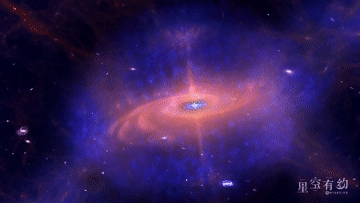
Animation shows the circulation inflow of gas in the galaxy. /Tsinghua University via Xinhua
Animation shows the circulation inflow of gas in the galaxy. /Tsinghua University via Xinhua
An international team of scientists has proved that gas recycling was the key factor in the formation of massive galaxies in the early universe. The discovery came after they observed a nebula located 11 billion light-years away.
After years of study, the team figured out the detailed process of circumgalactic gas entering this massive galaxy group and captured a three-dimensional view of its gas recycling, Tsinghua University in Beijing told a press conference on Friday.
According to the university, previous studies did not fully understand the process of how gas flows into galaxies and how this flowing gas drives star formation.
The team of astronomers from Tsinghua University and their counterparts from home and abroad used the Hawaii-based 10-meter Keck II telescope, which together with its twin telescope makes up the world's largest optical and infrared telescopes, and targeted a massive nebula, MAMMOTH-1, at an epoch corresponding to 11 billion light-years ago, to obtain the first glimpse of how such galaxies accrete their gas.
Their finding suggests that recycled gas from a previous era of star formation could play a critical role in sustaining star formation.

This diagram provided by Tsinghua University shows the process of gas recycling, which has been proved to be the key factor in the formation of massive galaxies in the early universe. /Tsinghua University via Xinhua
This diagram provided by Tsinghua University shows the process of gas recycling, which has been proved to be the key factor in the formation of massive galaxies in the early universe. /Tsinghua University via Xinhua
From the gas around the galaxy, the scientists detected emission lines from neutral hydrogen, helium and ionized carbon that extend 100 kiloparsecs from the galaxy.
By conducting spectral and numerical simulation analysis, the scientists concluded that this circumgalactic gas was likely ejected from the central black hole of the galaxy, then cooled down and circulated back into the galaxy under the combined effects of gravity and environmental angular momentum.
Kinematic modeling on the data showed enriched gas streams spiraling towards a colossal galaxy maintaining the star formation in the galaxy.
"This discovery provides a clear picture of how galaxies exchange matter with the large-scale environment, indicating that "circulation inflow" is an important mechanism that drives the formation of massive galaxies in the early Universe," said Cai Zheng, professor at the Department of Astronomy of Tsinghua University.
The research results were published online on May 5 in the journal Science.
(With input from Xinhua)